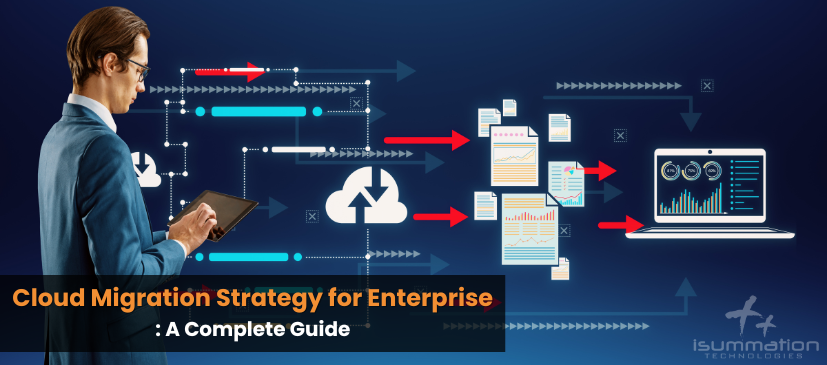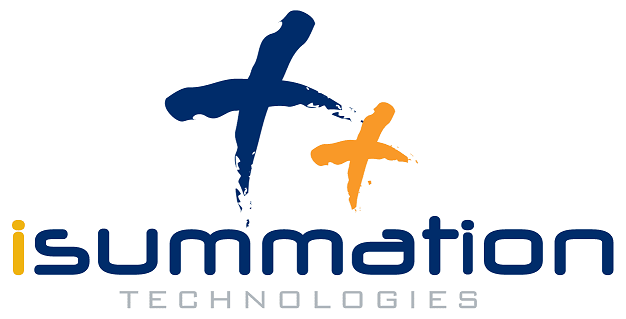- August 19, 2025
- Posted by: iSummation Team
- Category: Strategic IT

Cloud migration is more than a technical shift, it’s a full-scale business evolution. Organizations that master their cloud migration strategy gain competitive advantages in scalability, security, and innovation speed. This comprehensive guide provides a step-by-step blueprint for successful enterprise cloud migration.
Whether you’re planning your first application migration to cloud or developing a comprehensive cloud computing migration plan, this roadmap will help you navigate the complexities and achieve lasting success.
Why Enterprise Cloud Migration Is Critical for Modern Business?
Digital transformation has accelerated beyond expectations. Companies using traditional on-premises systems face mounting pressure to modernize their infrastructure. The shift to cloud-based migration offers compelling benefits:
Scalability advantages allow resources to expand, or contract based on real-time demand. This flexibility prevents over-provisioning during quiet periods and ensures adequate resources during peak usage.
Cost efficiency transforms capital expenditures into operational expenses. Pay-as-you-go pricing models eliminate the need for expensive hardware investments and reduce ongoing maintenance costs.
Enhanced resilience through high availability zones and disaster recovery capabilities ensures business continuity. Geographically distributed infrastructure minimizes downtime risks.
Advanced security features including encryption, identity management, and compliance certifications (HIPAA, ISO, GDPR) often exceed what organizations can achieve independently.
Innovation acceleration enables rapid adoption of AI/ML capabilities, automation tools, and DevOps practices that speed up application development and software development cycles.
Essential Components of Cloud Migration Planning
Assessment and Discovery Phase
Before planning cloud migration, take a deep dive into your present systems and workloads. This foundation determines the success of your entire migration journey.
- Inventory mapping requires cataloguing all applications, databases, servers, and their interconnections. Document dependencies between systems, as these relationships often create migration complexities. Include legacy applications that may require special handling during the transition.
- Goal definition clarifies your migration priorities. Are you primarily seeking cost reduction, improved agility, or enhanced security? Different objectives lead to different migration approaches and timeline considerations.
- Readiness evaluation examines your team’s cloud expertise, current security posture, and infrastructure maturity. Identify skill gaps early to plan training or external support needs.
- Financial modelling compares migration costs against projected savings. Include training expenses, potential downtime costs, and ongoing operational changes. This analysis justifies the investment and sets realistic budget expectations.
Cloud Migration Risk Assessment Framework
A comprehensive cloud migration risk assessment protects your organization from common pitfalls that derail migration projects.
- Technical risks include application compatibility issues, data integrity concerns, and performance degradation. Legacy applications may not function optimally in cloud environments without modification.
- Security risks encompass data exposure during transit, compliance violations, and access control challenges. Ensure your cloud migration plan addresses these concerns with specific security measures.
- Operational risks involve staff productivity impacts, business process disruptions, and vendor dependency concerns. Develop clear communication plans and training initiatives to reduce these impacts.
- Financial risks include budget overruns, unexpected licensing costs, and longer-than-anticipated migration timelines. Establish monitoring mechanisms and contingency budgets to manage these challenges.
Designing Your Cloud Computing Migration Plan
Selecting the Optimal Cloud Model
Your cloud migration strategy success depends heavily on choosing the right deployment model for your specific needs.
Public cloud platforms (AWS, Azure, Google Cloud) offer maximum scalability and global reach. These platforms excel for standard workloads and provide extensive service catalogues for application development and software development company.
Private cloud solutions deliver greater control and customization for sensitive workloads. Organizations with strict compliance requirements often prefer private environments for critical applications.
Hybrid cloud architectures combine public and private environments, enabling gradual migration approaches. This model works well for enterprises with diverse application portfolios and varying security requirements.
Multi-cloud strategies leverage multiple providers to optimize performance and avoid vendor lock-in. While complex to manage, this approach offers flexibility and redundancy benefits.
Migration Strategy Approaches
Different applications require different migration strategies. Your application migration strategy should align with business objectives and technical constraints.
Rehosting (lift and shift) switch applications with minor modification. This approach offers quick migration timelines but may not fully leverage cloud benefits. It works well for applications nearing replacement or with tight migration deadlines.
Replatforming makes targeted optimizations while migrating. Examples include switching to managed databases or updating operating systems. This balanced approach improves performance while controlling complexity.
Refactoring rebuilds applications for cloud-native architectures. While requiring significant effort, refactored applications fully exploit cloud capabilities like auto-scaling, microservices, and serverless computing.
Retire or retain decisions eliminate unnecessary applications or keep critical systems on-premises when appropriate. Not every application benefit from cloud migration, and strategic decisions save resources.
Application Migration to Cloud Checklist
Pre-Migration Preparation
Develop a comprehensive application migration to cloud checklist to assure nothing falls through the cracks during data transition.
Documentation requirements include application architectures, database schemas, integration points, and user access patterns. This information guides migration decisions and troubleshooting efforts.
Testing environment setup establishes cloud-based staging environments that mirror production configurations. Test applications thoroughly before committing to full migration.
Backup and rollback procedures provide safety nets if migration issues arise. Maintain current system snapshots and develop clear rollback criteria and procedures.
Communication planning keeps stakeholders informed about migration timelines, potential impacts, and success metrics. Clear communication reduces anxiety and builds support for the project.
Technical Implementation Steps
Infrastructure provisioning establishes cloud networks, security groups, load balancers, and monitoring systems. Configure these foundational elements before migrating applications.
Data migration execution transfers databases and file systems using appropriate tools and techniques. AWS Database Migration Service, Azure Migrate, and similar tools automate much of this process while maintaining data integrity.
Application deployment gets application code and configurations to cloud environments. Utilize containerization technologies like Docker and Kubernetes to streamline deployment and scaling processes.
Integration testing verifies that migrated applications connect properly with other systems, APIs, and third-party services. This step often reveals unexpected dependencies that require additional configuration.
Building Your IT Migration Strategy
Team Structure and Responsibilities
Successful migrating apps to the cloud requires coordinated effort across multiple teams and skill sets.
Migration provides strategic direction and replaces organizational hurdles. Executive sponsorship ensures adequate resources and helps resolve conflicts between competing priorities.
Technical teams handle the hands-on migration work including infrastructure setup, application migration, and testing activities. These teams need cloud platform expertise and traditional infrastructure knowledge.
Security specialists ensure compliance requirements are met and implement appropriate controls throughout the migration process. Their involvement prevents security gaps that could create vulnerabilities.
Business representatives validate that migrated applications meet functional requirements and business processes continue operating effectively. Their feedback guides optimization efforts.
Training and Change Management
Cloud migration success depends on preparing your organization for new ways of working.
Technical training develops cloud platform expertise within your IT teams. Invest in certifications and hands-on training programs that build practical skills.
Process updates modify operational procedures to reflect cloud environments. Incident response, capacity planning, and maintenance activities all change with cloud adoption.
Cultural adaptation encourages cloud-first thinking and agile methodologies. Traditional IT cultures may resist cloud adoption without proper change management support.
Cloud Migration Roadmap Development
Timeline Planning and Milestones
A well-structured cloud migration roadmap provides clarity and accountability throughout the migration journey.
Phase planning breaks large migrations into manageable chunks. Consider starting with less critical applications to build experience and confidence before migrating mission-critical systems.
Dependency sequencing ensures supporting systems migrate before dependent applications. Database migrations often must complete before application migrations can begin.
Resource allocation schedules team members and budget resources across migration phases. Stop overloading or creating resource conflicts between migration activities and ongoing operations.
Risk milestones establish checkpoints for evaluating progress and adjusting plans. Regular reviews help identify issues early when corrections are still manageable.
Performance Optimization Strategies
Cloud environments offer optimization opportunities that don’t exist in traditional infrastructure.
Auto-scaling configurations automatically adjust resources based on demand patterns. This capability reduces costs during low usage periods and maintains performance during peak demand.
Content delivery networks improve application performance by caching content closer to users. CDN implementation often provides immediate performance improvements for web applications development.
Database optimization leverages managed database services and cloud-native features like read replicas and automated backups. These services often perform better than self-managed alternatives.
Monitoring and alerting systems provide visibility into application performance and resource utilization. Cloud-native monitoring tools offer detailed insights that guide further optimization efforts.
Overcoming Common Cloud Migration Challenges
Technical Obstacles and Solutions
Even well-planned migrations encounter unexpected challenges that require creative solutions.
Legacy application compatibility issues arise when older applications don’t function properly in cloud environments. Address these challenges through containerization, application refactoring, or hybrid architectures that keep problematic applications on-premises temporarily.
Data transfer complexities emerge when moving large datasets or dealing with bandwidth limitations. Consider using physical data transfer services or scheduling transfers during off-peak hours to minimize impacts.
Performance degradation sometimes occurs when applications don’t behave as expected in cloud environments. Systematic performance testing and tuning often resolve these issues.
Integration challenges appear when cloud applications need to connect with remaining on-premises systems. API gateways and secure networking solutions typically address these connectivity requirements.
Organizational and Process Improvements
Skills development programs address knowledge gaps that could impede migration success. Invest in both technical training and cloud methodology education.
Governance frameworks establish policies and procedures for cloud resource management. Clear guidelines prevent cost overruns and security issues that commonly plague cloud adoptions.
Vendor management processes ensure effective relationships with cloud providers and migration partners. Enterprise app development company partnerships can accelerate complex migrations.
Budget controls implement cost monitoring and alerting mechanisms to prevent unexpected expenses. Cloud costs can drop quickly without proper oversight and controls.
Measuring Cloud Migration Success
Key Performance Indicators
Establish metrics that demonstrate migration value and identify improvement opportunities.
Cost metrics compare pre-migration expenses with post-migration costs, including both infrastructure and operational expenses. Factor in productivity improvements and new capability benefits.
Performance benchmarks measure application response times, availability percentages, and user satisfaction scores. These metrics demonstrate whether the migration achieved its performance objectives.
Security improvements track incident rates, compliance audit results, and security posture assessments. Cloud migrations should strengthen security, not weaken it.
Business agility indicators measure how quickly new features deploy and how rapidly the organization responds to market changes. These benefits often justify migration investments.
Continuous Optimization Practices
Cloud migration isn’t a one-time event—it’s an ongoing optimization journey.
Regular reviews assess performance, costs, and user feedback to identify improvement opportunities. Schedule monthly or quarterly reviews to maintain momentum.
Technology updates leverage new cloud services and features as they become available. Cloud providers continuously release improvements that can benefit your applications.
Refinement process enhances migration methodologies developed on lessons learned. Document best practices and challenges to boost future migration.
Conclusion
Small, steady steps build momentum. With a clear enterprise cloud migration strategy and a practical playbook, you can deliver value at each milestone and set your organization up for long-term success.


